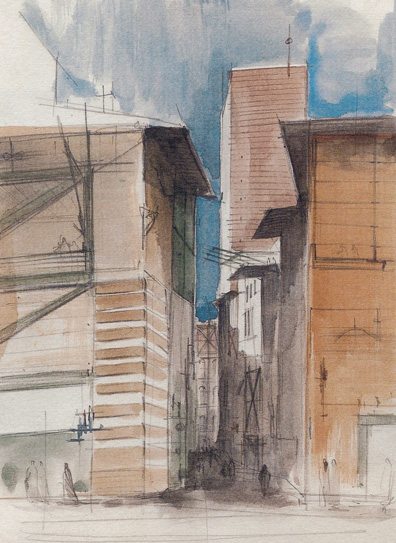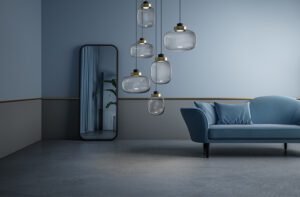Angela Raciti: The Lost Art of Sketching
February 19, 2013
For as long as I can remember, I’ve always loved to draw. Like all creatives, as much as I love to daydream, I like to see things in front of me. Now that I am about to graduate with a master’s degree in interior architecture, and with a handful of design positions under my belt, I know and understand just how much the industry relies on technology and the written word. Drawings and 3D models are “sketched†on the computer, and a paper trail follows every conversation.
 Sketch by and photo courtesy of Angela Raciti.
Sketch by and photo courtesy of Angela Raciti.
I know I’d be lost without my Pinterest boards and magazine clippings, but in my opinion, sketching is the best way to get your own ideas on paper. It’s a way to take your inspiration and make it your own. So many wonderful designers and architects understand how powerful of a tool sketching can be. In a world where easy-to-use technology is king, pulling out a sketchbook and pencil can feel like an awful lot of work compared to snapping a quick pic on our iPhones but, to me, a sketch is the easiest and fastest way to articulate ideas before others jump in and take their place. As artists, it’s important that we can express ourselves through this medium so our novel ideas can be documented. How many times have you had a great idea, but couldn’t find an image to illustrate it, so you couldn’t make your point?
There’s something about hand drawings that digitally created images just cannot capture. The expressive line, emotive pressure created by a pencil, paint, or ink touching the paper, and skillful understanding of form, perspective and scale create a unique expressiveness that has the power to transcend us to another place in time.
Adding fluid color to a simple seeming landscape transports us to the tranquil Florentine countryside.
 Sketch by and photo courtesy of Nacer Benkaci.
Sketch by and photo courtesy of Nacer Benkaci.
One of my first architectural sketches while sitting in the courtyard at the Boston Public Library. This technique, known as “scribble†is perfect if you aren’t skilled at drawing straight lines. I like how easy it was to create depth by intensifying your scribbles. A word of advice: a few cups of strong coffee help achieve this effect more easily.
 Sketch by and photo courtesy of Angela Raciti.
Sketch by and photo courtesy of Angela Raciti.
Aldo Rossi is one of Italy’s most influential twentieth century architects. This sketch illustrates the form by emphasizing its verticality. Simple, yet undeniably inspiring.
 From the Libro Azzurro, Jamileh Weber Galerie, Zurich, 1983. Seen in Paolo Portoghesi’s Aldo Rossi- The Sketchbooks.
From the Libro Azzurro, Jamileh Weber Galerie, Zurich, 1983. Seen in Paolo Portoghesi’s Aldo Rossi- The Sketchbooks.
Andrea Ponsi, an architect from Florence and California, uses sketches to investigate urban architecture. I like how just a few lines can tell his story.
 From Andrea Ponsi’s Changing Viewpoints.
From Andrea Ponsi’s Changing Viewpoints.
Below, Ponsi uses washes of color to show shadow and form in his Sdrucciolo dei Pitti.
 From Andrea Ponsi’s Changing Viewpoints.
From Andrea Ponsi’s Changing Viewpoints.
If you’ve ever been inside a structure as ornate as St. Sulpice Church in Paris, you know just overwhelming it can be to take it all in. There is so much to look at: motifs, decoration, and architecture on a huge scale. Reddig captured the romantic essence of this structure with the use of shading defined between edge lines.
 Photo from An Architect’s Paris by Thomas Carlson-Reddig.
Photo from An Architect’s Paris by Thomas Carlson-Reddig.
Benkaci’s sketch below of the duomo is both inspired and inspiring. His gestures tell the story of the architecture, and a small floor plan and notes goes into greater depth. He makes it look easy, right?
 Sketch by and photo courtesy of Nacer Benkaci
Sketch by and photo courtesy of Nacer Benkaci
As simple or complicated as you like, quick sketches only need to make sense to you. It’s your own personal documentation. Mathematical and structurally detailed, I’m sure Hejduk knew exactly what was going on in this sketch. I’m just happy I don’t need to decipher it!
 From Pewter Wings, Golden Horns, Stone Veils by John Hejduk.
From Pewter Wings, Golden Horns, Stone Veils by John Hejduk.
My favorite sketch of this post is by Reddig of Sorbonne Chapel. I have a thing for architectural sketches because they have a preciseness to them without being too exact. They are expressive. Don’t you just love the bicycle leaning against the front pilasters?! This picturesque, Baroque chapel is imperfectly perfect. Reddig gives the idea of capital motifs and statues, letting our minds fill in the details.
 Photo from An Architect’s Paris by Thomas Carlson-Reddig.
Photo from An Architect’s Paris by Thomas Carlson-Reddig.
Feeling daunted by the thought of putting pen to paper? I’ve been there. I remember the first drawing class I took where we had to draw from live models. It wasn’t pretty at first, but by the 4th class, I was getting in the groove. With practice, you will improve. I promise!
 Photo from An Architect’s Paris by Thomas Carlson-Reddig.
Photo from An Architect’s Paris by Thomas Carlson-Reddig.
-Angela RacitiÂ
Angela Raciti is about to graduate with a master’s degree in interior architecture from New England School of Art & Design in Boston, and has an undergraduate degree in Communications from Fairfield University. Her artwork has been honored by the Boston Globe and Published by St. Mary’s Press. She has held creative positions in high end residential design and architectural firms in and around Boston, and is the founder and author of the blog Diary of a Chair. Her artistic background has encouraged her interest in the interior collection of a space over time, as she believes that design is an organic process that is never truly complete.
Share
![NEH-Logo_Black[1] NEH-Logo_Black[1]](https://b2915716.smushcdn.com/2915716/wp-content/uploads/2022/08/NEH-Logo_Black1-300x162.jpg?lossy=1&strip=1&webp=1)







You must be logged in to post a comment.